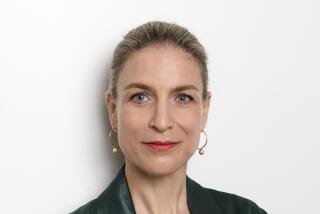End of discussion? Not by a long shot
When Paul Holdengraber resigned after five years as director of the Institute for Art & Cultures at the Los Angeles County Museum of Art last week, interested observers had two questions: What would become of the institute, and where was Holdengraber headed?
On Tuesday, museum officials said the institute will continue. But whether one or more people will fill Holdengraber’s role had yet to be decided, said Andrea Rich, director of the museum.
Holdengraber is leaving for the East Coast, where he will become director of public programs at the New York Public Library.
“I wanted to create a movable feast -- now I’m the one moving,” Holdengraber said. “The institute was this wonderful idea and adventure,” which should “have a life beyond five years. I wish them luck.”
“It was grand having him as the first facilitator of the institute,” Rich said, adding that the museum will experiment with the institute’s format.
Since its founding in 1998, the institute has sponsored a series of conversations about art and culture -- roughly once a month -- with participants such as author Susan Sontag, artist David Hockney and Museum of Jurassic Technology founder David Wilson.
“It is hard to imagine the institute without Paul, but I hope LACMA will invest in someone as energetic, intellectually rigorous, collaborative and ambitious as Paul to continue the programming of the institute,” said Samuel Hoi, president of Otis College of Art and Design. “He understood the right mix of substance, glamour and entertainment in cultural programming.”
The conversations often featured unusual pairings or cross-disciplinary meetings. Writers Dave Eggers and Ian Frazier appeared with Russian emigre artists Vitaly Komar and Alex Melamid on “The Healing Power of Art,” during which an elephant was brought to the museum and “audience members” were healed on stage.
Another event had Los Angeles Philharmonic conductor Esa-Pekka Salonen and director Peter Sellars sparring over Stravinsky.
“I wanted the institution to be a focal point for intellectual exploration -- something lacking in L.A.,” Rich said in 2000. “My instincts told me there was a hunger for it: If you build it, they will come.”
Indeed, the events -- held either in the museum’s Bing Auditorium or the LACMA West penthouse -- routinely sold out.
“Not only were his events wonderful, but they attracted an extraordinary audience,” said Ruth Seymour, general manager of Santa Monica public radio station KCRW-FM. “The speakers were often brilliant, and so was the audience.”
Discussions were often followed by questions from the audience and, later, drinks (with a cash bar in the museum courtyard).
“He made his institute in the museum a blazing center of conversation and interests,” said journalist and author Pico Iyer, who participated last year in a conversation about Islam and California. “I hope there will be many more salons to replace it because I think it really became a focal point for thinking and reading and debating in Los Angeles.”
Holdengraber launched the first event in December 1998. The following spring, a talk by painter R.B. Kitaj on Vincent van Gogh drew more than 1,000 people. Many had to be turned away because the Bing Theater seats only 600.
A man of a few thousand words, fond of quoting Oscar Wilde and Walter Benjamin, Holdengraber could exasperate those around him. Onstage during one event, architect Frank Gehry told Holdengraber to let composer and conductor Pierre Boulez speak.
From the audience, on another occasion, painter Ed Moses told him to allow others to ask questions of Philippe de Montebello, the director of New York’s Metropolitan Museum of Art, who had come to talk about elitism.
“Every once in a while, he had failures, but you don’t succeed if you don’t have failures,” Seymour said, adding that Holdengraber brought a free spirit to the museum. “It’s one of the hallmarks of an intellectually curious mind -- to take risks and not worry that people judge you a fool, because they will.”
“I am sorry that he is leaving LACMA,” said author Richard Rodriguez, a participant in the series who once described Holdengraber as “an intellectual Lenny Bruce.”
“Above all,” Rodriguez said, “he gave the city of Los Angeles a place for conversation.”
More to Read
The biggest entertainment stories
Get our big stories about Hollywood, film, television, music, arts, culture and more right in your inbox as soon as they publish.
You may occasionally receive promotional content from the Los Angeles Times.










